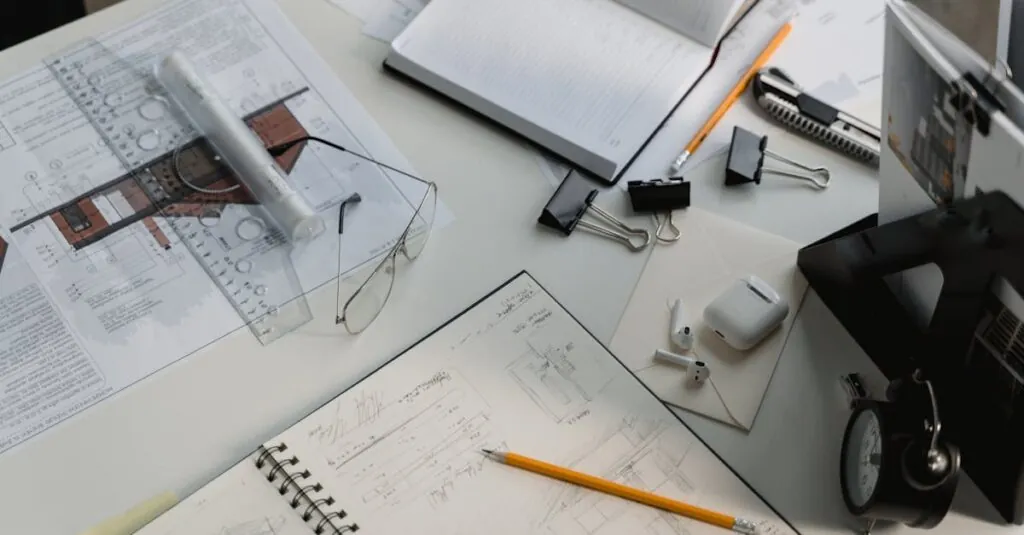Table of Contents
ToggleEver wondered how scientists study the mysteries of space without leaving Earth? Enter zero gravity research tools, the unsung heroes of the cosmos! These innovative gadgets let researchers explore the effects of microgravity on everything from human biology to material science, all while keeping their feet firmly on the ground.
Imagine conducting experiments that float in mid-air, like a magician pulling rabbits from a hat—or in this case, data from the void! With zero gravity tools, researchers unlock secrets that could revolutionize technology, medicine, and even our understanding of the universe. Buckle up as we dive into the fascinating world of these gravity-defying instruments that are making waves in scientific research.
Overview of Zero Gravity Research Tools
Zero gravity research tools include a variety of instruments designed for experiments in microgravity environments. These tools facilitate the examination of how materials and biological systems behave when subjected to conditions that mimic space. Researchers utilize specialized equipment like drop towers, parabolic flights, and sounding rockets to create temporary microgravity conditions.
Drop towers provide a cost-effective method for brief microgravity exposure. Experiments in these towers allow scientists to observe phenomena for several seconds. Parabolic flights offer short-duration microgravity experiences, lasting around 20-30 seconds per flight, enabling researchers to conduct experiments in a near-space environment. Sounding rockets achieve longer periods of microgravity, delivering more extended experiment durations of up to several minutes.
Additional instruments include centrifuges, which simulate increased gravity levels to compare results with those obtained in microgravity. Advanced imaging devices enhance the ability to capture critical data, giving insights into material behavior and biological processes. This combination of tools supports ground-based research aimed at preparing for potential missions to low Earth orbit and beyond.
Collaboration between scientists and engineers results in innovative solutions tailored for specific research needs. Understanding how various elements interact in microgravity can lead to breakthroughs in fields such as pharmaceuticals and advanced materials. As zero gravity research tools continue to evolve, the potential for transformative discoveries in science remains significant.
Types of Zero Gravity Research Tools
Zero gravity research tools encompass a variety of hardware and software designed to facilitate experiments in microgravity. Each tool plays a unique role in advancing scientific understanding.
Hardware Tools
Hardware tools include essential equipment such as drop towers, parabolic flight rigs, and sounding rockets. Drop towers enable brief, controlled falls that create microgravity conditions for approximately 2-10 seconds. Parabolic flights provide up to 30 seconds of microgravity through specialized flight paths. Meanwhile, sounding rockets can sustain microgravity for several minutes, ideal for in-depth experiments. Centrifuges also serve as hardware tools, simulating increased gravity for comparative studies. These innovative devices are fundamental for conducting a broad range of experiments across various scientific disciplines.
Software Tools
Software tools complement hardware by offering data analysis and simulation capabilities. Computational modeling software allows researchers to predict outcomes in microgravity environments. Data visualization tools help present complex results in an understandable format, making it easier to interpret findings. Other software options enable real-time monitoring of experiments, ensuring precise adjustments during testing. Analytical programs assist in extracting meaningful insights from experimental data. Together, these software tools enhance the efficiency and effectiveness of research conducted in zero gravity conditions.
Applications of Zero Gravity Research Tools
Zero gravity research tools play a crucial role in various applications. These tools enhance understanding in scientific research and aerospace engineering, contributing to significant advancements in these fields.
Scientific Research
Zero gravity research tools facilitate groundbreaking scientific studies. Microgravity conditions allow researchers to investigate fundamental biological processes, such as protein crystallization. This environment leads to the development of new pharmaceuticals through improved drug design and testing. Scientists also explore cellular behaviors that differ from those observed on Earth, yielding insights into diseases and aging. For example, investigations into muscle atrophy and bone density loss may provide solutions for astronauts and aging populations alike. Advanced imaging devices improve experiment monitoring, ensuring accurate data collection. Researchers benefit from collaboration across disciplines, fostering innovative studies that may reshape current understanding.
Aerospace Engineering
Zero gravity research tools significantly impact aerospace engineering. Testing materials in microgravity provides insights into their performance and durability in extreme conditions. Engineers analyze how materials behave without gravity, allowing for the design of lighter, more efficient spacecraft components. Additionally, understanding the mechanics of fluid dynamics in space helps develop better propulsion systems. Engineers also utilize parabolic flights to assess the impacts of microgravity on crewed missions, ensuring that human factors receive adequate attention. Continuous advancements in these tools promote safer and more effective space exploration. The knowledge gained through these applications enhances both engineering practices and the overall success of space missions.
Benefits and Challenges
Zero gravity research tools provide unique opportunities for scientific discovery but come with inherent challenges. Understanding these benefits and challenges helps researchers navigate this specialized field effectively.
Advantages of Using Zero Gravity Research Tools
Zero gravity research tools enhance scientific experimentation by offering insights into processes not observable under normal gravity conditions. They enable studies in fields such as human biology and material science, fostering breakthroughs in pharmaceuticals. In microgravity, protein crystallization becomes more efficient, which can lead to innovative treatments for various diseases. Furthermore, these tools contribute to advancements in aerospace engineering, leading to the design of stronger and lighter spacecraft components. The collaboration of scientists and engineers facilitates tailored solutions, optimizing the overall research process.
Common Challenges in Implementation
Implementing zero gravity research tools poses several challenges. High costs of equipment and maintenance can limit accessibility for some research institutions. Designing experiments in microgravity requires careful planning, as even minor changes can significantly affect results. Additionally, technical expertise is necessary for operating specialized equipment, making training essential for effective use. Other challenges include safety regulations and logistical coordination for experiments launched into space. Researchers must navigate these obstacles to harness the full potential of zero gravity environments.
Conclusion
Zero gravity research tools represent a pivotal advancement in scientific exploration. They unlock unique opportunities for understanding complex phenomena that gravity often obscures. As these tools become more sophisticated and accessible, their role in transforming fields like medicine and aerospace engineering will only grow.
The collaboration between scientists and engineers will drive innovation, leading to breakthroughs that can redefine our approach to various challenges. While obstacles remain, the potential benefits of these tools far outweigh the difficulties. Embracing the possibilities of zero gravity research can pave the way for a future rich with discovery and advancement.







